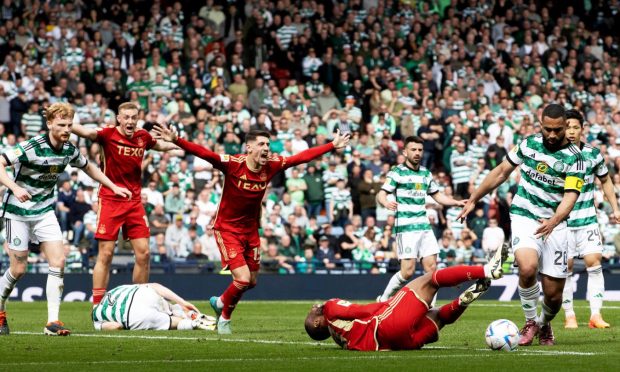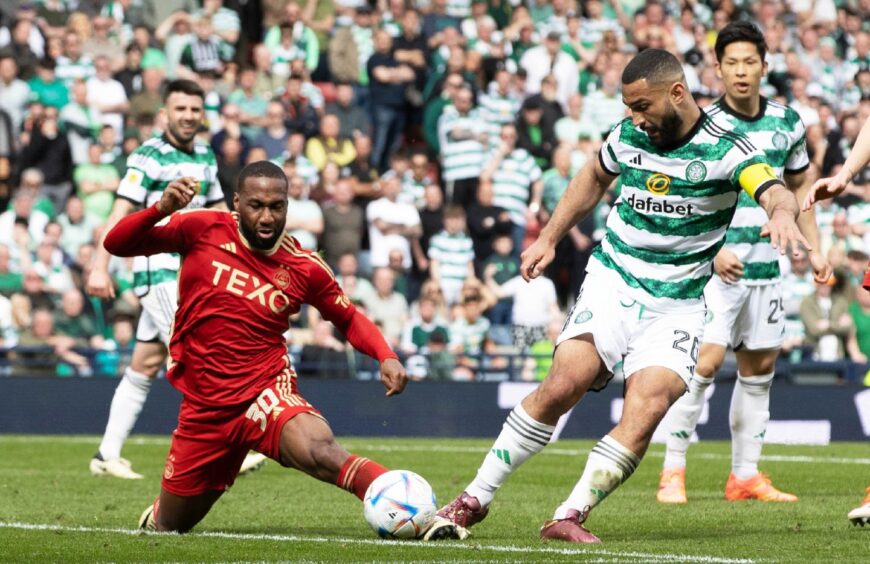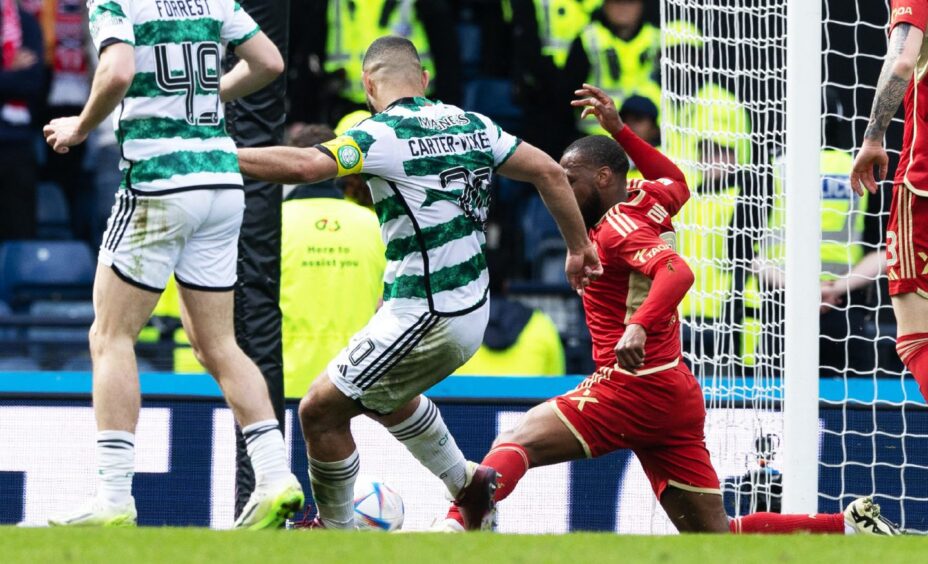Aberdeen’s valiant Scottish Cup semi-final efforts against Celtic ended with penalty shoot-out heartbreak – but there has been much focus on what I thought were poor performances from referee Don Robertson and VAR official Greg Aitken in the wake of Saturday’s tie.
Hesitant Angus MacDonald had to be stronger v Kyogo
Whistler Robertson’s first big call of the afternoon, which came when Kyogo outmuscled a hesitant Angus MacDonald in the build-up to Celtic’s equaliser to make it 1-1, was correct.
It wasn’t a foul. Kyogo got a good strong touch on the ball and MacDonald just needed to be stronger.
How did officials miss Liam Scales handball live?
However, the next significant flashpoint was a different story.
It came towards the end of the first half, when there were huge penalty shouts for handball against Celtic’s Liam Scales from Aberdeen‘s players and fans.
I was very surprised the handball wasn’t spotted live – by Robertson or the linesman on that side – as I could see from the stand it blatantly hit the hand of Scales.
A VAR check followed, and it was deemed the handball was not inside the box.
It was incredibly tight and could have gone either way as there was no definitive camera angle which showed exactly where Scales’ hand or the ball were when the contact was made.
The Irishman was clearly in the box, though his hand may have been slightly outside.
Carter-Vickers on Hoilett should have been stick-on penalty to Aberdeen… so why didn’t VAR intervene?
By far the biggest talking point on the semi-final came when Aberdeen were chasing a goal to make it 3-3 and take the clash to penalties.
Before MacDonald’s headed leveller late in extra-time to take it to spot-kicks, the Dons had a huge penalty shout for a foul on Junior Hoilett by Celtic’s Cameron Carter-Vickers.
Just to clarify the build-up to the incident…
A ball into the area was contested by Aberdeen’s Hoilett and his fellow Canadian Alistair Johnston.
The ball fell to the Dons‘ Jack MacKenzie, whose strike on goal was blocked.
Carter-Vickers looked to clear the loose ball and Hoilett stretched for the same ball, getting his leg in front, before Carter-Vickers kicked Hoilett’s leg and sent him sprawling.
There was clear contact – Carter-Vickers even put his head in his hands, knowing he had committed a foul.
Referee Robertson blew his whistle, and many people thought he had signalled for a penalty kick.
Despite muddled, confusing signalling – pointing to the spot while signalling for a Celtic free-kick – I could see a defensive free-kick had been awarded.
Firstly, if he thought the initial challenge was a foul, why did he wait for so much to unfold before giving it?
The referees now, with VAR, are told to allow play to finish before awarding a decision, which I can understand for offside, not fouls – but that’s why.
I don’t think the initial Hoilett-Johnston aerial challenge is a foul, though. It’s so soft – and if Johnston had done the same thing to Hoilett, Robertson would not have awarded a penalty to the Reds.
When it comes to Carter-Vickers on Hoilett, Aberdeen had a pretty solid case for a penalty. There was certainly enough in it.
I was surprised VAR did not ask Robertson to reconsider his decision to award Celtic a free-kick and give Aberdeen a penalty instead.
Put it this way: If the referee had given a pen in the first instance, would he have been asked to overturn it by VAR? Absolutely not.
Finlay Elder was a registered referee for six years and a category 5 official from 2019, with experience in the Highland League, Juniors and Club Academy.




Conversation